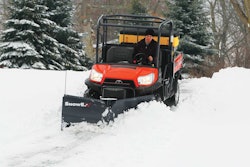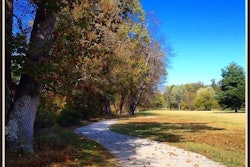 A Davey Tree technician provides sub-surface watering for a tree in need of treatment.
A Davey Tree technician provides sub-surface watering for a tree in need of treatment.Photo: The Davey Tree Expert Co.
Because the drought in parts of California and the desert Southwest has been so severe in recent years, it’s easy to forget that prolonged periods of exceptionally dry conditions are affecting many areas of the country.
It’s in those dry areas, The Davey Tree Expert Co. says, that trees may be suffering more than you know – and more than your landscaping clients realize.
More than you know, that is, because unlike drought-affected lawns, which have turned a tell-tale brown, the damage trees are sustaining from the same lack of water could take a year or longer to show up. What’s more, it can take several forms.
Rex Bastian, a Chicago area technical adviser with Davey Tree, knows all too well the damage that too little water can cause, yet he is quick to point that “overwatering can result in just as many problems …” Ironically, says Bastian, the problems caused by overwatering of trees, such as fine root death, can easily appear to have been caused by drought. Leaf browning, too, is often seen as a sign of drought, but it can also be a sign of overwatering, the arborist says.
Whether in providing advice to clients or in training your own landscape crews in proper tree care, Bastian says, it’s important to remember that mature trees need plenty of water, but they need it slowly, and in soil that enables water, if applied slowly, to reach deep roots.
Water the area under the tree’s canopy slowly and thoroughly, Bastian says, though not the trunk itself.
Although landscape companies without certified arborists on staff need to know when to call in an expert technician, Bastian says landscape professionals can learn a lot about tree care that will help them help their clients.
What they must realize first, however, is that with trees – much more than with turf or many other woody plants – it’s dangerous to jump to conclusions and difficult to generalize. In fact, a situation involving a tree may oftentimes turn out to be altogether different from a seemingly very similar situation involving a different tree in different soil.
For example, it may be that one tree is indeed showing signs of drought, while another tree – with nearly identical symptoms and signs – is actually showing signs of what happens when an insect damages the tree’s ability to circulate the water it’s getting from the roots to the canopy. In the first case, the problem is too little water. In the second, there’s plenty of water, but the insect-damaged tree is unable to take it up and circulate it effectively.
It’s worth noting that the tree’s susceptibility to insect infestation may have increased a year or more earlier due to drought stress.
Bastian suggest landscapers take a second look before rendering opinions on tree matters to their clients. They may well know exactly how to assess the situation, but given trees’ complexity, it pays to double-check, especially where important trees in the landscape are involved.
And one of the best practices when it comes to tree care?
“Making a habit of tracking the weather,” Bastian says. “NASA, NOAA, the National Drought Monitor … watching all those sources of information regularly will help you be prepared,” he says, “and it can help you know what to watch for.”










